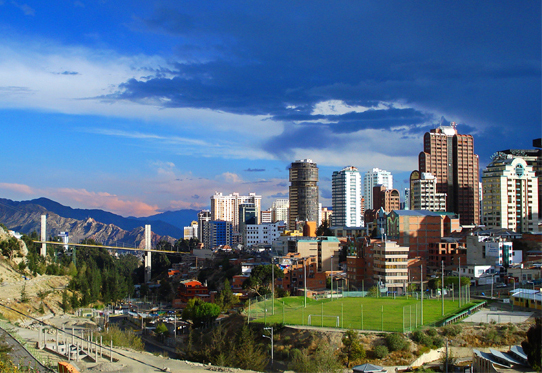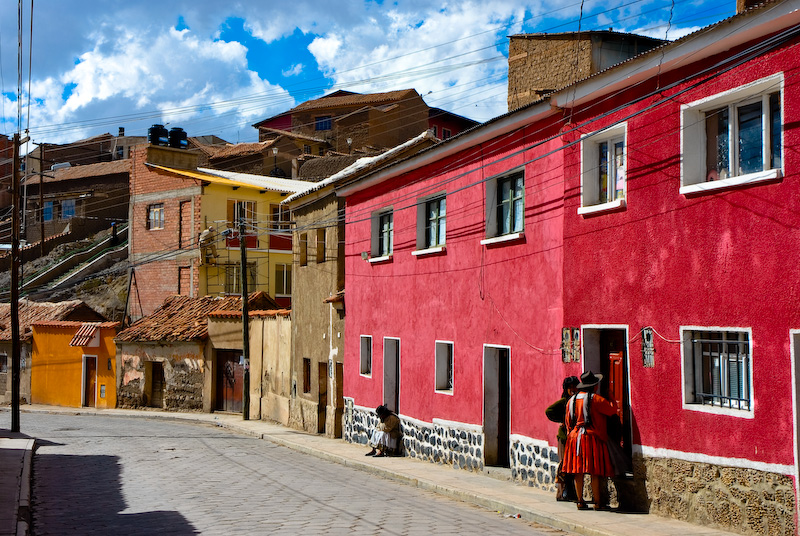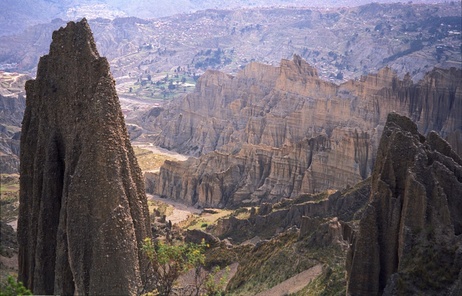WORLD TRAVEL NEWS ARTICLE
BOLIVIA
Bolivia, landlocked, impoverished and possessing the world’s highest capital city of La Paz, continues to dispute its boundaries, never having been able to forgive or accept the outcome of wars with its neighbours that saw its Pacific Ocean frontier pushed back. Its former land with the port of Antofagasta now belonging to Chile and its former vast grazing lands now in the hands of Paraguay.

La Paz, Bolivia
To the north and east, Bolivia’s neighbour is Brazil ; to the south, Argentina and Paraguay. Chile and Peru are on its western borders and Peru owns half of Bolivia’s Lake Titicaca.
The poorest of all South American countries, Bolivia has seen 190 different governments in 150 years since it gained its independence from Spain in 1825. Ironically, given its poverty, Bolivia is the world’s fifth largest producer of tin; it also has gold, silver and zinc mines, and sources of natural gas and petroleum.
Bolivia also makes a substantial income for coca. Although this income is immeasurable because of its illegality, it is thought to be far higher than that achieved from legal exports.
Two arms of the mighty Andes mountain range run through Bolivia, and well over two thirds of the country’s entire population of nearly nine million live here in the western high plateau between the two arms, which is known as the Altiplano. Known as the Aymara people, they eke out a living from the unrewarding soil, growing potatoes and maize and rearing vicunas, alpacas, sheep and llamas.
A shortage of rain adds to the difficulties of farming in this cold hostile terrain and these Amerindian campesinos live in thatched mud huts that give poor protection against the elements. They lack schooling and the only hope they have of improving their way of life is to go and work in the mines. Despite the hardships they endure, these hardworking people always have a ready smile; they wear colourful cheerful clothing and are extremely friendly. (The wearing of bowler hats by the women originated with an order from Spain in the 1700s and is the custom to this day.)
Recent government initiatives will hopefully filter through to raise the standard of living here, but as nearly 70% of the population scratch out an existence in the Altiplano, this will be no mean undertaking.
With the recovery from the 1980’s inflation rate of an unbelievable 35,000% per annum still ongoing, and the economy’s collapse only averted by wholesale job losses and consequent massive unemployment it is no surprise then that coca crop growing continues in the face of US disapproval and disincentive schemes. Socialist President Evo Morales was himself a coca farmer and may yet still be able to secure compromise in this land of contradictions.
The east of the country covers a far larger land area and has far less population. The land is fertile with cattle ranching to the south, sugar cane, tobacco, tropical fruit, nuts and coffee grow in the north, making the people who live in this area far more prosperous. Timber, mainly for export purposes, comes from the tropical forests of the north east
Currency is the boliviano. 1 bolivano = 100 centavos. For the latest exchange rates visit www.xe.com
Spanish, Quechua and Aymara are the languages spoken.
La Paz is the administrative capital, with Sucre being the judicial capital.
El Alto International Airport at La Paz and at 13,000 ft above sea level it is the highest international airport in the world. Taxis to the centre of La Paz take about 30 minutes and minibuses run regularly with many drop off points.
For current visa requirements visit www.projectvisa.com
La Paz
Viewed from the rim of the Altiplano, this is a magical mountain-wrapped city. Viewed from ground level it is something of a pollution trap. However alluring the view of Mount Illimani (towering at 19,000 ft above the city) may be you will be aware of the pollution around you.

Governor's Palace, La Paz
If you are going to explore the Bolivian Highlands by way of daily excursions from La Paz be prepared for altitude sickness and ease yourself gently into your sightseeing programme. There will be a lot of climbing up and down the steep streets of the city and Coca tea (Mate de coca) is an altitude sickness cure you may wish to try. Coca tea drinking is a social event in Bolivia.
La Paz has many museums, several of them with themes relating to the country’s various wars, they record events of the War of the Pacific. The Litoral Museum, displays a banner categorically stating that “Bolivia has not, and will never, lose its right to the Pacific”.
Street markets abound, with stalls selling fruit, vegetable, snacks, drinks, nuts and herbs, handicrafts including ponchos, blankets, jerseys, ear flap caps, to the most eyebrow raising of magic charms – oils, llama parts and small models of “gods”.
The cathedral is quite modern and close to the city centre’s Murillo Square (named for Pedro Domingo Murillo who died at the hangman’s hands after leading an 1809 uprising against the Spanish). You will find old cobbled streets and elegant colonial buildings here. Of these, Calle Jaen is a pedestrian-only zone which allows you to wander (traffic free) while you admire the architecture. Attached to the church of St. Francis is an old monastery with noteworthy carvings.
Bolivian music is wonderful, played on a range of pipes and flutes, guitars, drums and rattles and is extraordinarily haunting. You can hear it in the penas (folk clubs) every night in La Paz where groups from all over the country travel to perform.
Sucre
Known as the “real” capital of Bolivia, nearly 400 miles away to the south east offers much historic interest and has many museums. Bolivia’s Declaration of Independence was signed in the House of Liberty. This building is open to the public and is situated in 25 May Square. Nearby is the cathedral, and cathedral museum. Well maintained, lovely old churches, convents and monasteries abound in Sucre.

Sucre, Bolivia
Che Guevara spent the last months of his life in his Bolivian Campaign mounted to the east of Sucre. On 8 October 1967 he was killed in the village of La Higuera. Pilgrimages are available today visiting the village and other places of the campaign nearby. (The remains of Che Guevara and his comrades were removed from La Higuera in 1997 and flown to Cuba where they were buried with full military honours in the city of Santa Clara in the province of Las Villas where Che had won the decisive battle of the Cuban Revolution.)
Potosi
The Silver City to the west of Sucre has been designated a World Heritage Site and is a monument to the greed of mankind. Virtually redundant now, this huge city was built by the Conquistadores who came to mine the huge red mountain for silver. The city contains some of the best colonial buildings of South America, fading relics of past glory, teetering into disrepair. Visitors walk through the city streets to see the faded grandeur of the “City of the Rich”. A visit to the Mint should not be overlooked. Tours of its rooms, which are now arranged as a museum, house an astonishing number of artefacts.

Potosi houses
Mine tours are available, but are very primitive and claustrophobic and not for the fainthearted, or anyone with a lung or breathing condition. Watching the miners offer a daily cigarette to The Devil is the reason most people choose to go underground, but a visit should not be a priority in your list of things to see and do.
Cochabamba
Bolivia’s third city, lies halfway between Sucre and La Paz and is where you should base yourself if you intend to visit the Inca ruins at Inkallajta and Inka Rakay.
Tourists flock to the Chilean border to see the world’s largest salt lake at Uyuni (tours start from both Sucre and Potosi) along with the flamingos of Lake Colorado and the hot springs at Chalviri.
On the Brazilian border near the town of Trinidad a river boat tour is a must. These are not luxury cruise liners – you share your river boat with the fruit and veg being transported up or down river – but it makes for a unique bird watching journey for anyone prepared to forego luxury. For information about the weather in Bolivia visit www.worldweather.org
You may also like to read

BRAZIL - South America
Tour-smart travellers will already know that the excitement is building in the massive country.

CHILE - South America
Long, diverse and fascinating, Tour-smart introduces you to Chile, a ribbon of land 2,700 miles long on the Pacific coast of South America.

Comments